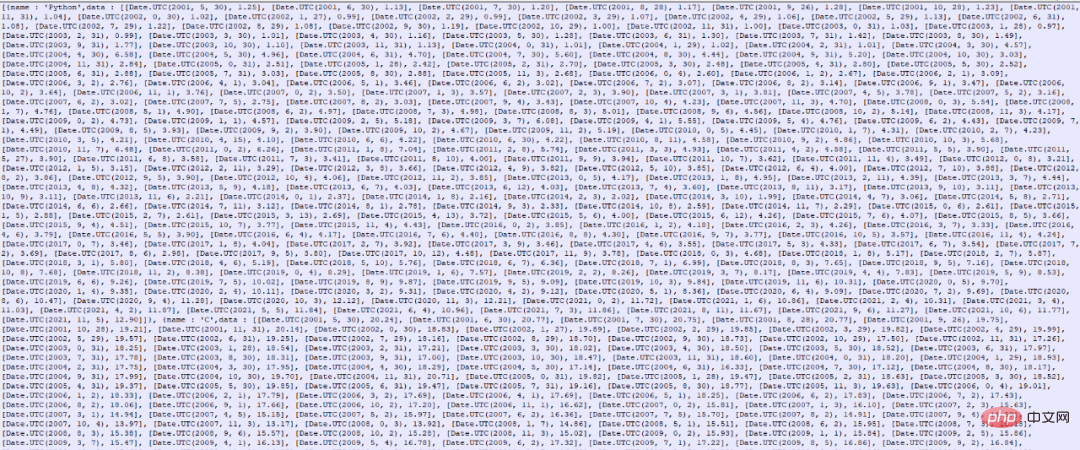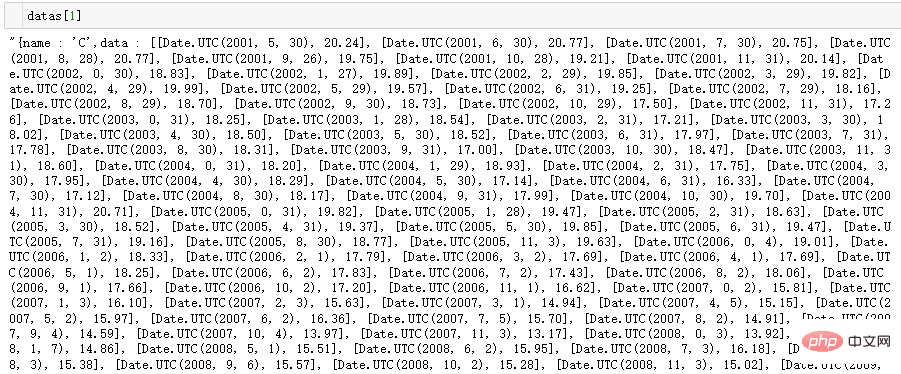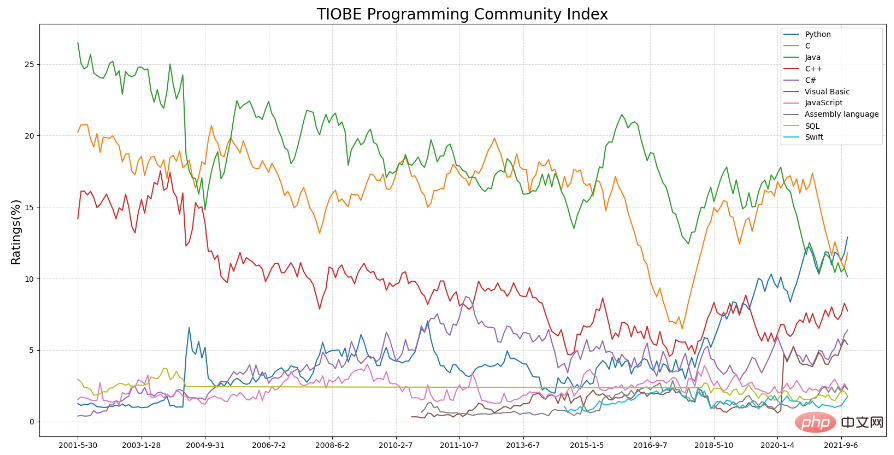 Backend Development
Backend Development
 Python Tutorial
Python Tutorial
 Python practical series | Regular data extraction and drawing
Python practical series | Regular data extraction and drawing
Python practical series | Regular data extraction and drawing
 ## At first glance, it looks like a json format file. In fact, it looks like a json format file. The above is not
## At first glance, it looks like a json format file. In fact, it looks like a json format file. The above is not
 Let’s get to the point:
Let’s get to the point: ?️? 5. Data extraction part Complete code ?️? 6. 绘图 绘图部分直接用matplotlib的plot循环绘制即可,代码如下:with open('data.txt') as f:
data = f.read()datas = re.findall('({.*?})',data)


re.findall('\'(.*)\'',datas[0])[0]
re.findall('(\d+(\.\d+)?)',datas[0])
for i in range(0,len(datas_tmp),4):
datas_f.append(float(datas_tmp[i+3][0]))
dates_f.append(f'{datas_tmp[i][0]}-{datas_tmp[i+1][0]}-{datas_tmp[i+2][0]}')# 处理数据
with open('data.txt') as f:
data = f.read()
datas = re.findall('({.*?})',data)
names = []
dates_result = []
datas_result = []
for idx,dd in enumerate(datas):
datas_f = []
dates_f = []
name = re.findall('\'(.*)\'',dd)[0]
names.append(name)
datas_tmp = re.findall('(\d+(\.\d+)?)',dd)
for i in range(0,len(datas_tmp),4):
datas_f.append(float(datas_tmp[i+3][0]))
dates_f.append(f'{datas_tmp[i][0]}-{datas_tmp[i+1][0]}-{datas_tmp[i+2][0]}')
datas_result.append(datas_f)
dates_result.append(dates_f)# 绘图
plt.figure(figsize=(20, 10), dpi=100)
for i in range(len(names)):
plt.plot(dates_result[i], datas_result[i], label=names[i])
ax = plt.gca()
ax.xaxis.set_major_locator(ticker.MultipleLocator(20))
plt.ylabel("Ratings(%)", fontdict={'size': 16})
plt.title("TIOBE Programming Community Index", fontdict={'size': 20})
plt.legend(loc='best')
plt.grid(True, linestyle='--', alpha=0.5)
plt.show()
The above is the detailed content of Python practical series | Regular data extraction and drawing. For more information, please follow other related articles on the PHP Chinese website!

Hot AI Tools

Undresser.AI Undress
AI-powered app for creating realistic nude photos

AI Clothes Remover
Online AI tool for removing clothes from photos.

Undress AI Tool
Undress images for free

Clothoff.io
AI clothes remover

AI Hentai Generator
Generate AI Hentai for free.

Hot Article

Hot Tools

Notepad++7.3.1
Easy-to-use and free code editor

SublimeText3 Chinese version
Chinese version, very easy to use

Zend Studio 13.0.1
Powerful PHP integrated development environment

Dreamweaver CS6
Visual web development tools

SublimeText3 Mac version
God-level code editing software (SublimeText3)

Hot Topics
 Is there a mobile app that can convert XML into PDF?
Apr 02, 2025 pm 09:45 PM
Is there a mobile app that can convert XML into PDF?
Apr 02, 2025 pm 09:45 PM
There is no APP that can convert all XML files into PDFs because the XML structure is flexible and diverse. The core of XML to PDF is to convert the data structure into a page layout, which requires parsing XML and generating PDF. Common methods include parsing XML using Python libraries such as ElementTree and generating PDFs using ReportLab library. For complex XML, it may be necessary to use XSLT transformation structures. When optimizing performance, consider using multithreaded or multiprocesses and select the appropriate library.
 Is there any mobile app that can convert XML into PDF?
Apr 02, 2025 pm 08:54 PM
Is there any mobile app that can convert XML into PDF?
Apr 02, 2025 pm 08:54 PM
An application that converts XML directly to PDF cannot be found because they are two fundamentally different formats. XML is used to store data, while PDF is used to display documents. To complete the transformation, you can use programming languages and libraries such as Python and ReportLab to parse XML data and generate PDF documents.
 How to convert XML files to PDF on your phone?
Apr 02, 2025 pm 10:12 PM
How to convert XML files to PDF on your phone?
Apr 02, 2025 pm 10:12 PM
It is impossible to complete XML to PDF conversion directly on your phone with a single application. It is necessary to use cloud services, which can be achieved through two steps: 1. Convert XML to PDF in the cloud, 2. Access or download the converted PDF file on the mobile phone.
 How to control the size of XML converted to images?
Apr 02, 2025 pm 07:24 PM
How to control the size of XML converted to images?
Apr 02, 2025 pm 07:24 PM
To generate images through XML, you need to use graph libraries (such as Pillow and JFreeChart) as bridges to generate images based on metadata (size, color) in XML. The key to controlling the size of the image is to adjust the values of the <width> and <height> tags in XML. However, in practical applications, the complexity of XML structure, the fineness of graph drawing, the speed of image generation and memory consumption, and the selection of image formats all have an impact on the generated image size. Therefore, it is necessary to have a deep understanding of XML structure, proficient in the graphics library, and consider factors such as optimization algorithms and image format selection.
 How to open xml format
Apr 02, 2025 pm 09:00 PM
How to open xml format
Apr 02, 2025 pm 09:00 PM
Use most text editors to open XML files; if you need a more intuitive tree display, you can use an XML editor, such as Oxygen XML Editor or XMLSpy; if you process XML data in a program, you need to use a programming language (such as Python) and XML libraries (such as xml.etree.ElementTree) to parse.
 Is there a free XML to PDF tool for mobile phones?
Apr 02, 2025 pm 09:12 PM
Is there a free XML to PDF tool for mobile phones?
Apr 02, 2025 pm 09:12 PM
There is no simple and direct free XML to PDF tool on mobile. The required data visualization process involves complex data understanding and rendering, and most of the so-called "free" tools on the market have poor experience. It is recommended to use computer-side tools or use cloud services, or develop apps yourself to obtain more reliable conversion effects.
 How to beautify the XML format
Apr 02, 2025 pm 09:57 PM
How to beautify the XML format
Apr 02, 2025 pm 09:57 PM
XML beautification is essentially improving its readability, including reasonable indentation, line breaks and tag organization. The principle is to traverse the XML tree, add indentation according to the level, and handle empty tags and tags containing text. Python's xml.etree.ElementTree library provides a convenient pretty_xml() function that can implement the above beautification process.
 Is the conversion speed fast when converting XML to PDF on mobile phone?
Apr 02, 2025 pm 10:09 PM
Is the conversion speed fast when converting XML to PDF on mobile phone?
Apr 02, 2025 pm 10:09 PM
The speed of mobile XML to PDF depends on the following factors: the complexity of XML structure. Mobile hardware configuration conversion method (library, algorithm) code quality optimization methods (select efficient libraries, optimize algorithms, cache data, and utilize multi-threading). Overall, there is no absolute answer and it needs to be optimized according to the specific situation.





